The Appalachian Hub Part 2: The Charleston WV Hub
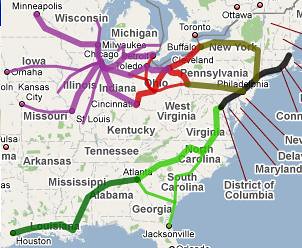 The increasingly infamous Appalachian Development Highway program started out with the goal of supporting the potential for genuine economic development in Appalachia by improving transport links into and within the region.
The increasingly infamous Appalachian Development Highway program started out with the goal of supporting the potential for genuine economic development in Appalachia by improving transport links into and within the region.And yet, with the decentralized, state-based system for planning 110mph, 125mph and 220mph High Speed Rail systems, there is the threat that the very problem that the Appalachian Development Highway system was established to address will be re-created as we modernize our regional passenger transport backbones from asphalt to steel.
An Appalachian Hub project would aim to drag these laudable goals into the 21st Century by filling the gaping hole in Eastern US planning for High Speed Rail systems. "Would", since this is an exploration of what such a system might look like if West Virginia, Kentucky and Tennessee joined this planning process - not a report on ongoing, formal projects such as the Midwest Hub or Ohio Hub.
______________________________
The Story So Far
The Appalachian Hub Pt. 1 presented the problem of the gaping hole in the middle of Eastern US planning to build Emerging High Speed Rail systems - the tilt-train systems that allow us to quickly roll-out higher speed passenger rail by using existing rail corridors.
This process also provides the improved rail access to urban centers required by Express High Speed Rail systems as well as increasing the potential ridership of Express High Speed Rail system by acting as a passenger recruiter.
Two trunks of the network were Atlanta / Chattanooga / Nashville / Louisville / Indianapolis and Memphis / Nashville / Chattanooga / Knoxville / Tri-Cities / Roanoke and points northeast.
The 21st Century Steel Interstate examined the proposed I-81 "trial" Steel Interstate system, for electrified Rapid Freight Rail and Regional High Speed Rail from Harriburg, PA to Knoxville, TN along the Shenandoah River Valley alignment.
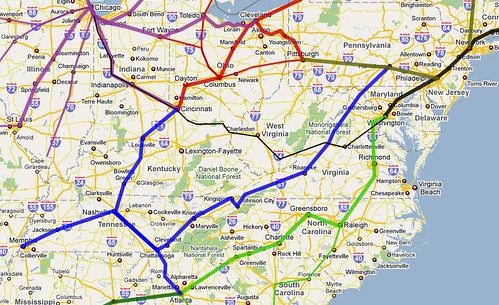 Modifying the original trunks to fit this existing proposal results in one trunk that completes the circle around Appalachia and one that cuts through Appalachia running from the Northeast toward the Southwest. Also shown is the existing conventional rail Amtrak route from DC to Chicago via Charleston, WV.
Modifying the original trunks to fit this existing proposal results in one trunk that completes the circle around Appalachia and one that cuts through Appalachia running from the Northeast toward the Southwest. Also shown is the existing conventional rail Amtrak route from DC to Chicago via Charleston, WV.The Problem of Coal
Today's focus is West Virginia, and zooming into West Virginia reveals one of the central challenges facing the Appalachian Hub project. A dominant market for rail transport in West Virginia is coal - and so, unlike the industrial and interurban electric Rights of Way established in places like Ohio and Indiana and Illinois, a large number of rail lines in West Virginia do not run through - they run to the coal mine, which is the original railhead, and then stop.
Indeed, in hilly and mountainous terrain, this allows a certain kind of "cheating" on the rail line, where empty rail cars are going uphill while full rail cars are going downhill ... which is much less work than the other way around.
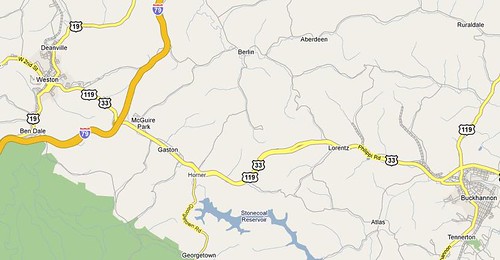 The result is that often you have rail lines that are not all that far apart, on a straight line path, but one rail line connects to the north (the lines that run up through Weston in the map), the other rail lines connects to the south (the lines that run through Buckhannon in the map), and they do not connect.
The result is that often you have rail lines that are not all that far apart, on a straight line path, but one rail line connects to the north (the lines that run up through Weston in the map), the other rail lines connects to the south (the lines that run through Buckhannon in the map), and they do not connect.And of course, once a project shifts from increasing the capacity of an existing rail line in an existing right of way to establishing a new right of way through hilly and mountainous terrain - the costs of the project will certainly explode.
However, as described long ago in Route Matrix Revolutions (Daily Kos, 7 April, 2007), a rail service has a striking competitive advantage over other common carrier services, and especially over air services, in terms of the low time cost of stopping the train to pick up and drop off passengers. The time penalty is the most dramatic for a plane, but even for a regional bus, leaving the Interstate to find its way to an urban bus station imposes far more time penalty than a train stopping at a station.
So Stage One is upgrading the route that already exists through West Virginia. The first step is to upgrade the capacity of the existing Amtrak route through West Virginia, to allow on-time passenger services - which includes a capability to catch up when experiencing a delay, rather than one delay creating another creating another, as so often happened in 2007 and 2008 when oil price shocks were increasing demand for rail freight.
The second step is to upgrade the speed of the existing Amtrak route, first by operating tilt-trains under the current 79mph maximum speed limit, and then by raising the maximum speed limit to 110mph.
This then supports an increase in frequency.
And that is the combination - reliable schedules, faster trip speeds, and more frequent service - that lays the foundation for establishing a route matrix with Charleston, WV, as its hub.
Going the Easy Way
 Stage Two is a service from Charleston to the West, collecting westbound passengers from the existing (but more reliable, faster, and more frequent) DC/Chicago service and collecting eastbound passengers. Further west, the alignment crosses existing planned 110mph Higher Speed routes, ending in Saint Louis (Note that while I have traced out an existing rail right of way, it is not shown in the schematic).
Stage Two is a service from Charleston to the West, collecting westbound passengers from the existing (but more reliable, faster, and more frequent) DC/Chicago service and collecting eastbound passengers. Further west, the alignment crosses existing planned 110mph Higher Speed routes, ending in Saint Louis (Note that while I have traced out an existing rail right of way, it is not shown in the schematic).Now, we won't be worrying about "all those empty seats" from passengers transferring at Charleston, WV for the westbound service that originates there, since the higher speed NYC/DC/WV/IN/Chicago service will be able to recruit passengers in Charleston for Cincinnati, Indianapolis and Chicago, and of course will be able to recruit in Cincinnati to fill seats toward Chicago from the Ohio Hub's Triple C line.
Going the Hard Way
Now, with Charleston established as a Hub, the third stage cuts across Appalachia the hard way.
There is an obvious hole in the coverage of the Ohio Hub which is, by no coincidence, precisely in the heart of the Appalachian counties of Ohio. The Pittsburgh/Columbus alignment is actually two alignments, with a corridor originating in Zanesville and running through Newark to double the frequency of services from Licking County into Franklin County.
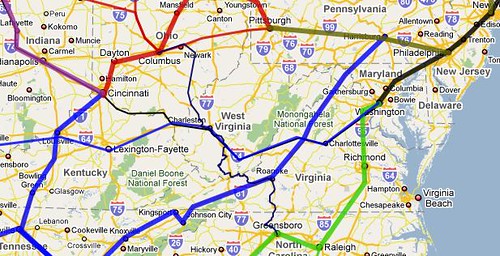 Stage Three offers to fill this hole by extending that corridor down to Athens, Ohio, and then on to Charleston, WV, to share the NYC/DC/WV/IN/Chicago corridor and then cross to Roanake, terminating at Greensboro on the Southeast Express Corridor. Note that the route appears more irregular since the pictured route more closely follows existing rights of way - and that this is definitely terrain where operating a conventional passenger service rather than a tilt-train would be a mistake even if a maximum speed limit of 79mph or 90mph is applied.
Stage Three offers to fill this hole by extending that corridor down to Athens, Ohio, and then on to Charleston, WV, to share the NYC/DC/WV/IN/Chicago corridor and then cross to Roanake, terminating at Greensboro on the Southeast Express Corridor. Note that the route appears more irregular since the pictured route more closely follows existing rights of way - and that this is definitely terrain where operating a conventional passenger service rather than a tilt-train would be a mistake even if a maximum speed limit of 79mph or 90mph is applied.With this route addition, Charleston, WV acts even more strongly as a hub. The Columbus/WV/Greensboro train would be scheduled to arrive in advance of the Chicago/WV/DC train at Charleston, and depart after it. The role of "local and express" would be reversed at Roanoke, where the Columbus/WV/Greensboro train would connect with Richmond and Bristol VA with the proposed TransDominion Express.
One of the primary reasons for placing this in Stage three is that it is a major potential beneficiary of network economies at connections to services that do not yet exist, at Columbus OH, at Charleston WV, at Roanoke VA, and at Greensboro NC.
Leaving WV to connect WV
There is one last link in the Charleston Hub segment of the Appalachia Hub - and it is neither a High Speed Rail corridor nor does it pass through Charleston, WV. Yet it relies on the Route Matrix to connect the capital of WV to much of the north of the state.
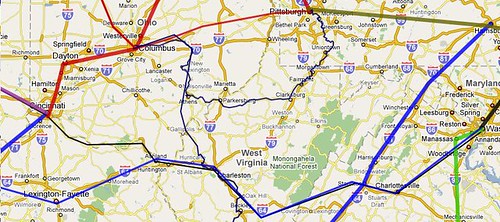 The "Mountaineer" connects Parkersburg, Clarksburg, Fairmont, and Morgantown to Columbus via Athens and Pittsburgh via Uniontown. With the Columbus/Greenboro line, a passenger can transfer at Athens between Charleston and points to the Southeast and West Virginia towns along the Mountaineer. Note that this corridor looks even squigglier, in large part because the process of lining it up along existing rail rights of way (for estimating route-miles for a later essay) is almost complete - but also because the terrain means that most through rail corridors run along fairly narrow river valleys.
The "Mountaineer" connects Parkersburg, Clarksburg, Fairmont, and Morgantown to Columbus via Athens and Pittsburgh via Uniontown. With the Columbus/Greenboro line, a passenger can transfer at Athens between Charleston and points to the Southeast and West Virginia towns along the Mountaineer. Note that this corridor looks even squigglier, in large part because the process of lining it up along existing rail rights of way (for estimating route-miles for a later essay) is almost complete - but also because the terrain means that most through rail corridors run along fairly narrow river valleys.So, that's the Charleston WV Hub
I hope that it clearer why I have been calling this hypothetical system "The Appalachian Hub" rather than "The Appalachian Express Corridor". In order to gain full benefit from Route Matrix effects, and also because of the tyranny of geography, the system is not based along a single trunk backbone, nor as a single centralized hub and spoke "wheel", but rather as a decentralized hub and link network. So it is a "hub" based system, but based on hubs strategically placed through the Appalachian region.
Of course, until the problem of funding is sorted out, its rather like a road train going nowhere ...
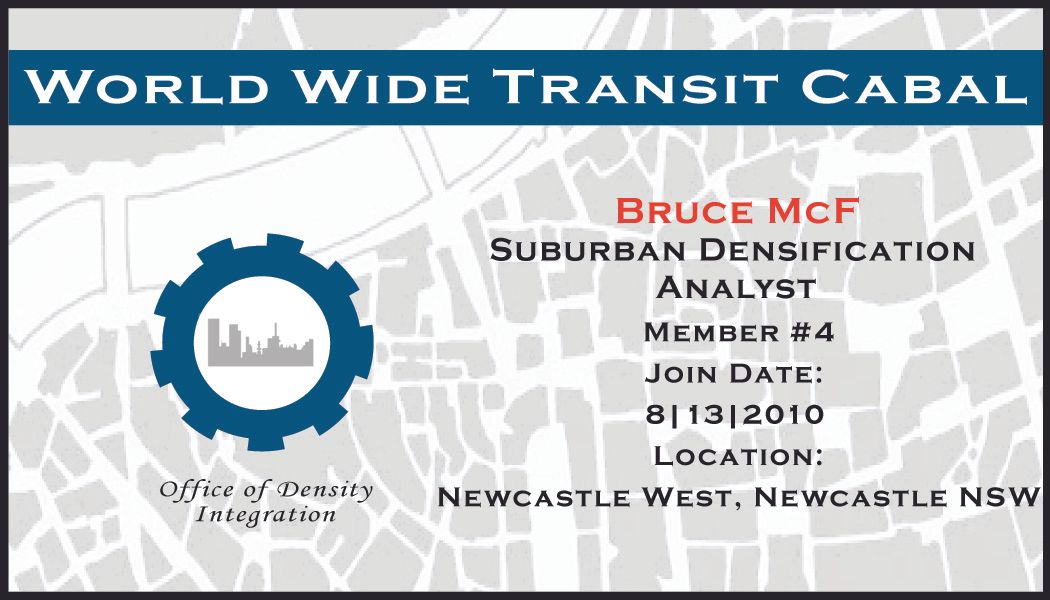

3 comments:
What you propose has points that might happen in the world of political reality. Faster, on time, and more frequent scheduling on the CSX/C&O might take place. Three trains a day each way are essential for good departure/arrival times along the Norfolk-Richmond-Washington to Cinainnati route. An essential aspect is adding express bus connections to off the line cities. Except for buses, there is no realistic way for north south service in WV. Buses could be first class operations, removed from the "Midnight Cowboy" environment, with union rail/bus stations in places such as Charleston and Huntington. The station would have direct interstate connection as well as the std pull up and stop arrangement for the railroad, secure long/short term parking and shuttle service to the airport for those changing modes. Enroute the bus would be fast with stops near interstate ramps. without rambling to a downtown stop. The main rail route needs to go to Columbus as well as Cincinnati, not what you propose through Zanesville or whatever. The tilt train is an excellent idea for one schedule. The other two daily schedules need conventional equipment and income producers such as express freight including auto carriers.
What you propose has points that might happen in the world of political reality. Faster, on time, and more frequent scheduling on the CSX/C&O might take place. Three trains a day each way are essential for good departure/arrival times along the Norfolk-Richmond-Washington to Cinainnati route. An essential aspect is adding express bus connections to off the line cities. Except for buses, there is no realistic way for north south service in WV. Buses could be first class operations, removed from the "Midnight Cowboy" environment, with union rail/bus stations in places such as Charleston and Huntington. The station would have direct interstate connection as well as the std pull up and stop arrangement for the railroad, secure long/short term parking and shuttle service to the airport for those changing modes. Enroute the bus would be fast with stops near interstate ramps. without rambling to a downtown stop. The main rail route needs to go to Columbus as well as Cincinnati, not what you propose through Zanesville or whatever. The tilt train is an excellent idea for one schedule. The other two daily schedules need conventional equipment and income producers such as express freight including auto carriers.
A single route cannot go from Charleston to both Cincinnati and Columbus: Columbus is essentially North by Northwest and Cincinnati is essentially West by Northwest ... the three cities make a triangle more than a single run. Hence the existing Cardinal route continuing.
However, the two Columbus routes in the map do both go to Columbus. Its at Chilicothe that they diverge, one running to northern WV and one running to central WV. By having one route inbound from one part arrive at a Chilicothe before the other route outbound to the other part reaches the station, a third, Charleston/Huntington return trip is provided without requiring additional trains.
Post a Comment